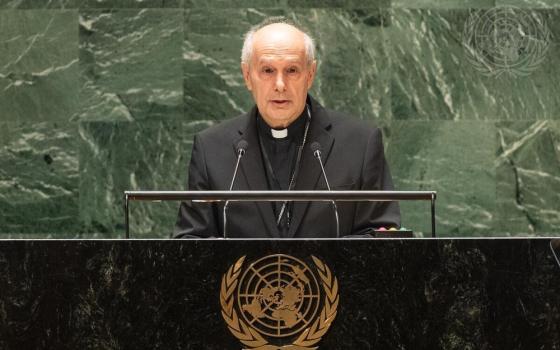WASHINGTON -- U.S. Catholic seminary enrollment in theology this year is the highest in almost a quarter-century, the Center for Applied Research in the Apostolate reported in the spring issue of its quarterly newsletter, The CARA Report.
The reported growth in seminarians, however, does not begin to match the growth in the U.S. Catholic population, which has increased by about 25 percent in that time period.
"This year's total of 3,723 is the highest enrollment since the 3,788 reported for 1988-89," CARA said.
"During the academic year 2011-12, enrollment increased by 63 diocesan seminarians and religious enrollment by 52 seminarians" over the 2010-11 figures, the report states.
CARA, based at Georgetown University in Washington, D.C., has been reporting yearly enrollment figures and other data on U.S. Catholic seminaries and seminarians since the 1967-68 academic year.
At that time, there were more than 8,000 seminarians studying theology, more than 13,400 students in college seminaries, and almost 16,000 high school seminarians.
Since then, U.S. high school seminaries have almost disappeared -- down to four programs enrolling 448 students in the current school year, according to the latest CARA study -- and college seminary enrollment has dropped almost 90 percent, to 1,355 students in the current academic year.
CARA said the current year's total of college seminarians was down 105, or 7 percent, from the previous year, and high school enrollment dropped by 84, or 16 percent.
The lower high school and college figures reflect long-term U.S. Catholic cultural trends toward later vocational discernment that CARA and other sociologists of religion have been analyzing and discussing for many years.
In describing the new increase in theology students, CARA also qualified comparisons with its 1988-89 figures.
In its annual surveys since 1994, it said, "theologate totals also include pre-theology students who may have degrees in another undergraduate discipline but need up to two years of study in philosophy, theology or formation to qualify for full theologate enrollment."
In other words, back in 1988-89, CARA was still counting those in post-graduate but pre-theology programs as collegiate seminarians. Since 1994, it has counted them among theology students, while specifying how many of them are still in pre-theology -- typically about 20 percent for most of the last 18 years.
Before 1994, the number of pre-theology seminarians who already had college degrees but not enough philosophy or other background to enter directly into a post-graduate theology program of studies was relatively small, since many of the students enrolling in graduate-level theological seminaries were still coming from college seminaries where they had received enough undergraduate formation in philosophy and other disciplines to prepare them for graduate-level theological studies.
By 1994, the gradual increase in the number of college graduates enrolled in Catholic theological seminaries but engaged in fulfilling undergraduate prerequisites for postgraduate theological studies had grown to the point where CARA had to begin incorporating it as a distinct statistical category in its yearly seminary survey.
New Vatican scholastic background requirements in philosophy and undergraduate theology introduced in 1994 added a second year before post-graduate theology formation for most college graduates who had not attended a college seminary, substantially increasing the number of post-college pre-theology students reported in CARA data since then.
In other data from this year's survey, CARA reported:
- The average retention rate from seminarians entering theology to being ordained priests has remained pretty constant over the past several years at about 75 percent. "Of the 709 seminarians who began theologate study in 2008, 520 are completing their fourth year in 2012," it said.
- Slightly more than a fourth of today's theology seminarians are 35 or older, more than half are under 30 and about one-fifth are between 30 and 35, representing a possibly significant shift back toward youth after a couple of decades in which newly ordained priests tended to be much older than ordination classes of the 1950s to 1980s, when nearly all new ordinands were in their mid- to late 20s.
"The proportion of older seminarians has been decreasing in recent years," CARA reported. "For example, five years ago more than a third of theology students were age 35 or older."
The new seminary data also confirmed a growing trend toward foreign-born priests, who, according to other CARA studies, now account for about 6,000 of the nation's current active priests working in parishes or other ministries.
"In 2011-12, 892 [theology-level] seminarians or 24 percent are from 81 foreign countries," the report states. It said most of them come from Mexico, Colombia, Vietnam, the Philippines, Poland and Nigeria.
While some of the foreign-born seminarians in U.S. theologates are preparing for ordination in dioceses abroad or in religious orders based outside the United States, almost two-thirds of those studying for diocesan priesthood are preparing for ordination in a U.S. diocese, and more than two-thirds of those preparing for priesthood in a religious order are planning to become priests of a U.S.-based religious order.
In short, roughly two-thirds of current post-graduate seminarians preparing for priesthood in the United States, whether as diocesan or religious priests, are foreign-born.
In a separate study also covered in the spring issue of The CARA Report, CARA said "the graying of the priesthood is the one trend that is perhaps having the most immediate impact on priestly life in the United States."
It reported that the average age of U.S. Catholic priests rose from 45 in 1970 to 59 in 2009, and new ordinations "are still only about a third of the number that are needed to compensate for those priests who are retiring, dying or leaving active ministry."
"The number of seminarians, in decline in the 1970s and 1980s, has stabilized to about 3,500 seminarians enrolled in theology each year," it said. "However, ordinations are still only about a third of the number that are needed to compensate for those priests who are retiring, dying or leaving active ministry."
[Jerry Filteau is NCR Washington correspondent. His email address is jfilteau@ncronline.org.]



